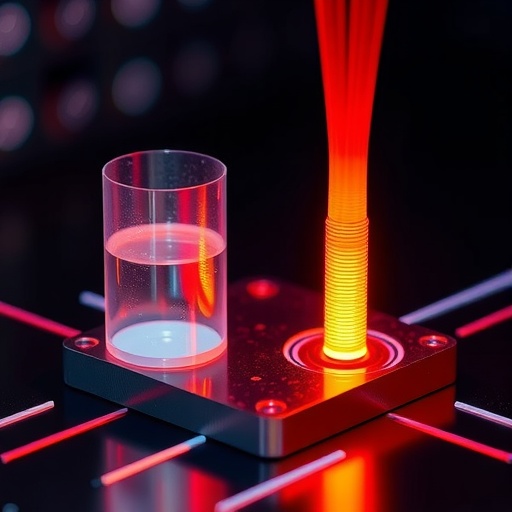Amorphous oxide semiconductors have recently emerged as promising candidates for use in advanced electronics, specifically as thin channel materials in back-end-of-line processes. These types of materials offer significant advantages, including flexibility and reduced thickness, making them suitable for modern high-performance devices. However, despite their potential, they also present significant challenges, most notably Joule heating. This phenomenon arises from the inherent local disorder within these amorphous materials, which leads to strong scattering of both electrons and phonons, significantly impacting performance under high-speed and power-intensive conditions.
In a groundbreaking study, researchers have demonstrated that the performance of amorphous indium tin oxide (ITO) can be notably enhanced by utilizing a silicon carbide (SiC) substrate. This innovation is crucial, as silicon carbide is known for its superior thermal conductivity and mechanical strength. By leveraging these properties, the researchers have effectively addressed the challenges related to Joule heating, enabling the use of ITO in high-efficiency transistors without the usual degradation under stressful operational conditions.
The experimental setup involved the fabrication of top-gate transistors with channel lengths measuring just 120 nm. Such a miniaturized scale is critical for advancing the capabilities and performance of semiconductor devices, particularly in fast electronics where speed is paramount. Notably, these transistors exhibited remarkable resilience, maintaining their performance stability even in high electric fields and elevated temperatures reaching up to 125 °C. This resilience is vital for applications requiring reliability and durability under extreme conditions.
One of the most telling performance metrics achieved in this study was the cutoff frequency of 103 GHz. This figure illustrates the swift operational capabilities of the developed transistors, showcasing their potential for high-frequency applications. Even more impressive is the maximum oscillation frequency, which reached 125 GHz. Such high-frequency performance positions these ITO-based devices as strong contenders for integration into next-generation wireless communication systems, where speed and efficiency are crucial.
The research further extends into the realm of power amplification, an area that is gaining increasing importance in modern electronic circuits. The indium tin oxide power amplifiers created in this study demonstrated a high output power density of 0.69 W/mm, a figure that underscores the potential for substantial signal amplification in compact device architectures. This capability could lead to the development of more powerful yet efficient communication systems, especially as the demand for data transmission continues to rise globally.
In addition to their output power capabilities, the ITO amplifiers achieved a power-added efficiency of 24.1% at a frequency of 12 GHz. This efficiency rating is particularly noteworthy, as it indicates a significant reduction in wasted power, which is a common issue in conventional amplifiers. The ability to maintain such efficiency while providing robust output power is essential for modern applications, especially in devices that rely on battery power or have strict thermal management requirements.
The study not only showcases the potential of amorphous indium tin oxide but also opens avenues for further research and development in the field of electronics. By understanding the mechanisms through which the silicon carbide substrate enhances the properties of ITO, researchers can explore other combinations of materials that may yield similar or even better performance outcomes. This collaborative interplay between materials science and electronic engineering is critical for pushing the boundaries of what is currently possible in high-tech devices.
Additionally, the findings emphasize the importance of addressing thermal management in electronic device design. Joule heating in thin-film transistors is a critical issue that can lead to device failure, particularly in applications that require rapid switching and high power. By improving the thermal dissipation capabilities through substrate choice, as demonstrated in this research, the longevity and reliability of future electronic devices can be significantly enhanced.
The influence of localized structural disorder on electronic properties cannot be overstated. In amorphous materials, this disorder typically leads to degraded performance due to scattering mechanisms that disrupt the flow of electrons. The successful alleviation of such issues in the present study suggests that further advancements in synthetic methodologies for producing amorphous semiconductors could yield materials with tailored properties.
As the demand for compact, high-performance electronics continues to grow, the integration of novel materials like ITO into conventional semiconductor technology becomes increasingly important. The work presented not only provides an immediate solution to current challenges but also sets a foundation for future innovations that capitalize on the unique properties of amorphous semiconductors.
In conclusion, the research on amorphous indium tin oxide transistors presented here represents a significant leap forward in the technology of electronic devices. By overcoming the conventional limitations of thin film transistors through the use of silicon carbide substrates, these advancements not only improve operational performance but also open up new possibilities in the realm of high-frequency electronics. The compelling results encourage both further exploration and practical applications, and stand to make a significant impact in the field of electronics in the years to come, potentially revolutionizing how we design and utilize future electronic devices.
As the landscape of technology continues to evolve, embracing novel materials that push the boundaries of traditional semiconductor physics will be key. This research highlights the dynamic interplay between material science and electronic engineering, paving the way for innovations that may one day become the backbone of next-generation high-speed and energy-efficient devices.
The journey of amorphous semiconductors is just beginning, and as researchers delve deeper into these materials’ properties and capabilities, it is not far-fetched to envision a future where our electronic devices are smarter, faster, and more efficient than ever before.
Subject of Research: Amorphous indium tin oxide transistors for power amplification
Article Title: Amorphous indium tin oxide transistors for power amplification above 10 GHz.
Article References: Hu, Q., Zhu, S., Zhu, Y. et al. Amorphous indium tin oxide transistors for power amplification above 10 GHz.
Nat Electron 8, 803–809 (2025). https://doi.org/10.1038/s41928-025-01447-6
Image Credits: AI Generated
DOI: https://doi.org/10.1038/s41928-025-01447-6
Keywords: Amorphous Semiconductors, Indium Tin Oxide, Silicon Carbide Substrate, Joule Heating, Power Amplifiers, High-Frequency Electronics, Transistor Performance




